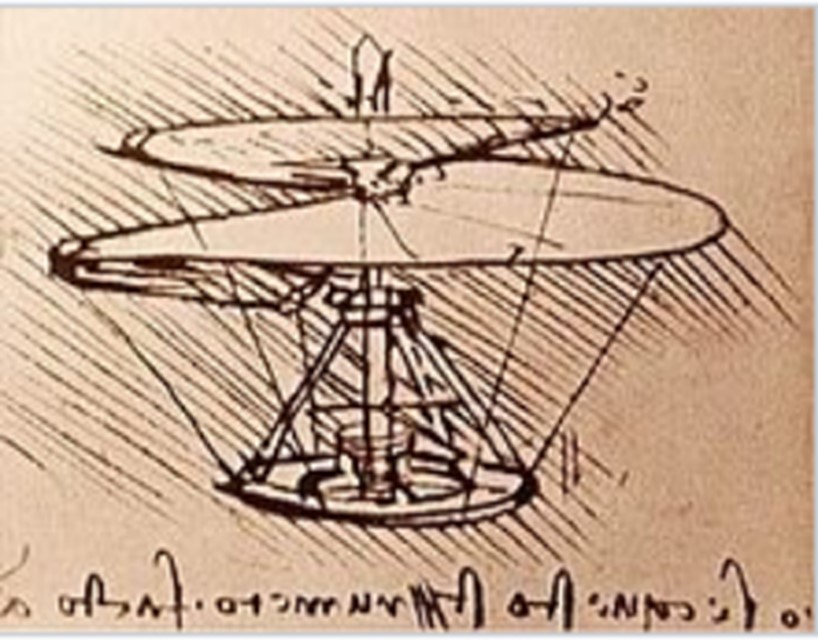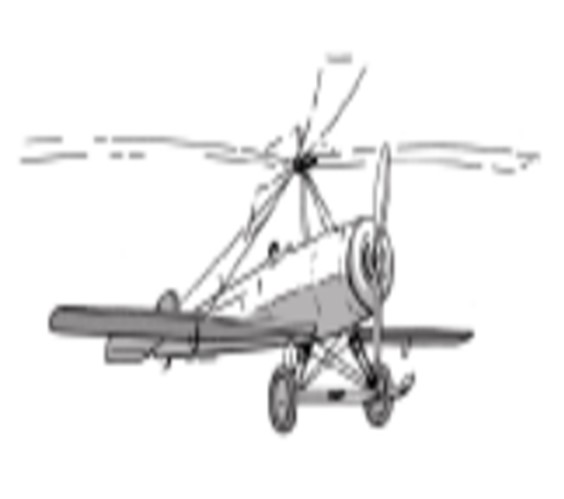Helicopter Operations - Preliminaries
1/76
Earn XP
Description and Tags
Name | Mastery | Learn | Test | Matching | Spaced |
|---|
No study sessions yet.
77 Terms
Helicopter
considered one of the heavier-than-air aircraft developed through time and need for the advancement of transportation.
Helicopter
Also known as “rotorcraft”, “rotary wing” aircraft, and “chopper”
helix
greek word that means spiral
pteron
greek word that means wing
1100 (Chinese Flying Top)
reportedly describes some of the ideas inherent to rotary-wing aircraft.

1480 (Leonardoo Da Vinci)
Created a design called “Aerial Screw”

1784 (Launoy and Bienvenu)
Feather model which was created more successfully in 1870 by Alphonse Penaud in France.
1870 (Charles-Alphonse Penaud)
August 18, 1871: Inherently stable airplane called Planophere.
1843 (Sir George Cayley)
Father of fixed-winged flight
Aerial Carriage
Governable parachutes
1907 (Breguet Brothers and Charles Richet)
Made Gyroplane no. 1
1907 (Paul Cornu)
A bicycle maker like the Wright Brothers
Attained a free flight of 20 seconds duration
With twin-rotor craft powered by a 24-horsepower engine.
1912 (Jacob Ellehammer)
a helicopter that featured contrarotating rotors and cyclic pitch control.
1916 (István Petroczy and Theodore von Kármán)
proposed an electrically driven rotorcraft to replace the dangerously flammable observation balloons.
George de Bothezat (1924)
for the U.S. Army Air Force lifted off the ground for slightly less than two minutes, under minimum control.
Argentine inventor Raúl Pateras Pescara
designed several helicopters in the 1920s and ’30s that applied cyclic pitch control
736 meters (2,415 feet)
straight-line distance record on April 18, 1924
May 4, Étienne Oehmichen
established a distance record for helicopters by flying a circle of a kilometre’s length.
1923 (Juan de la Cierva)
Father of the Autogyro
First practical rotorcraft

1936 (Focke-Wulf)
designed the world’s first practical transverse twin-rotor helicopter, the Fw 61
Fw 61
also known as the Fa 61
1938 (Hanna Reitsch)
the world’s first female helicopter pilot flying the Fa 61 inside the Deutschland-Halle in Berlin.
1938 (Flettner Kolibri)
was the first to place a helicopter into mass production
1938 (Igor Sikorsky)
turned his attention to helicopters once again, and after a long period of development, he made a successful series of test flights of his VS-300 in 1939–41.
commercial use of helicopters
fire fighting, police work, agricultural crop spraying, mosquito control, medical evacuation, and carrying mail and passengers.
Fuselage
the outer core of the airframe
is an aircraft’s main body section that houses the cabin which holds the crew, passengers, and cargo.
Engine
it is the source of power of the helicopter
Landing Gear
It is the understructure that supports the helicopter in ground or during landing; it may be a skid or a gear type.
Tail boom
It is the part of the helicopter that houses the portion of the tail drive and tail rotor assembly.
It is the part of the helicopter that counter acts the torque produced by the main rotor system.
Tail Rotor System
It is the part of the helicopter that counter acts the torque produced by the main rotor system. It is used to maintain the directional heading of the aircraft.
Main Rotor System
the rotating part of a helicopter which generates lift.
Gyroplane
spiderweb-like frame and four sets of rotors
airfoil
sometimes called as aerofoil is the cross-sectional shape of a wing or rotor blades in helicopter.
Blade Span
the length of the rotor blade from center of rotation to tip of the blade.
Chord Line
a straight line intersecting leading and trailing edges of the airfoil.
Chord
the length of the chord line from leading edge to trailing edge; it is the characteristic longitudinal dimension of the airfoil section.
Mean Camber Line
a line drawn halfway between the upper and lower surfaces of the airfoil.
Middle Line
Leading Edge
the front edge of an airfoil.
Flight Path Velocity
the speed and direction of the airfoil passing through the air.
Relative Wind
defined as the airflow relative to an airfoil and is created by movement of an airfoil through the air.
In aeronautical term, it is the direction of the wind or the movement of the atmosphere relative to the aircraft or an airfoill.
Pitch Angle
It is the acute angle between the rotor blade chord and the reference plane.
Trailing Edge
the rearmost edge of an airfoil
Induced flow
the downward flow of air through the rotor disk
Resultant relative wind
relative wind modified by induced flow
AOA (Angle Of Attack)
the angle measured between the resultant relative wind and the chord line
Angle of Incidence (AOI)
the angle between the chord line of a blade and rotor hub.
Center of Pressure
the point along the chord line of an airfoil through which all aerodynamic forces are considered to act.
Rotor Droop
the blades are somewhat flexible, and when at rest will droop due to the weight and span of the blade
Tip Path Plane
the tips will pass through a circular surface formed by the rotor blades
also known as rotor disk
Dynamic Droop
is how much the blades can move downward as a result of maneuvering and aerodynamic forces when at full operating RPM.
Lift
opposes the downward force of weight, is produced by the dynamic effect of the air acting on the airfoil and acts perpendicular to the flightpath through the center of lift.
Thrust
is the force produced by the power plant/ propeller or rotor. It opposes or overcomes the force of drag. As a general rule, it acts parallel to the longitudinal axis.
Weight
It is the combined load of the aircraft itself, the crew, the fuel, and the cargo or baggage.
Drag
Is a rearward, retarding force caused by disruption of airflow by the wing, rotor, fuselage, and other protruding objects.
opposes thrust and acts rearward parallel to the relative wind.
Drag
Is a rearward, retarding force caused by disruption of airflow by the wing, rotor, fuselage, and other protruding objects.
opposes thrust and acts rearward parallel to the relative wind.
Induced Drag
generated by the airflow circulation around the rotor blade as it creates lift.
Parasite Drag
is present any time the helicopter is moving through the air.
This type of drag increases with airspeed.
Total Drag
the sum of all three drag forces.
Translating Tendency
tendency for the whole helicopter to drift in the direction of the tail rotor thrust.
Ground Effect
It appears when the helicopter is within one-half of a rotor diameter from the ground.
Translational Lift
This is an additional lift which is obtained when entering horizontal flight due to the increased in efficiency of the rotor system.
Autorotation
Is the process of producing lift with the rotor blades as they freely rotate from a flow of air up through the rotor system.
Ground Resonance
It is a self-excited vibration which, as the name implies, occur on the ground.
This problem is associated with fully articulated rotor systems and is the result of geometrical imbalance of the main rotor system.
Torque
It is the force when power is applied to the rotor system the fuselage of the helicopter will tend to move in the opposite direction of the rotor.
Anti-torque rotors are used to eliminate this.
Gyroscopic Precession
It means that action occurs 90 degrees from the force applied in the same direction as rotation.
Blade Stall
the condition under which the streamline flow of air separates from the camber of the blade and reverse flow occurs, resulting in almost loss of lift.
Coriolis Effect
It is the change in blade velocity to compensate for the change in distance at the center of the axis rotation as the blade flaps.
Stability
It is a term used to describe that behavior of an aircraft after it has been disturbed from its trimmed position.
Static Stability
It means that after a disturbance, the tendency is to return to its original position.
Dynamic Stability
It is the term used to describe the behavior of the object after the disturbance.
Single Main Rotor
creation of torque as the engine turns the rotor creates a torque effect
simple design
lower maintenance cost
maneuverability
advantages of single main rotor
higher torque
anti-torque system is required
less power
disadvantages of single main rotor
tandem rotors
two horizontal main rotor assemblies mounted one behind the other
co-axial rotor
pair of rotors mounted one above the other on the same shaft
intermeshing rotors
set of two rotors turning in opposite direction
also called synchropter
transverse rotors
mounted on the end of the wings
quad rotors
comprises four rotors in an x configuration
also known as quadcopter